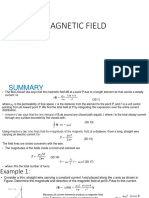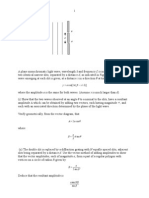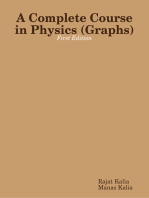EMT-Tutorials-2025-Set3
Uploaded by
22026762011EMT-Tutorials-2025-Set3
Uploaded by
22026762011Electromagnetic Theory & Electrodynamics – Tutorials 2025
Problem Set 3
1. A rod of length 80 cm is inclined at an angle 60◦ from the x0 -axis in an inertial frame S 0 which moves
with a speed 0.8 c in the x direction in another inertial frame S, all of whose axes are oriented parallel to the
corresponding ones in S 0 . Find the angle the rod makes with the x-axis in the frame S.
2. A beam of muons travels with a speed v = 0.6c in the laboratory. If the mean life-time of a muon in its rest
frame is 2.2 × 10−6 s, what fraction of the intial number of muons in the beam would decay after traveling 15m
in the laboratory? [Given: The number density of muons is N (t) = N (0) exp(−t/τ ), where τ is the observed
life-time of a muon in motion.]
3. A rectangular slab of glass, of refractive index n and of proper thickness D, moves to the right with a speed
v, as shown in the figure below. Suppose that a flash of laser light, emitted from a point A on the left of the
slab, passes through it and gets detected at a point B on its right. If the distance between A and B is L, then
to an observer in the laboratory frame, how long would it take for the light to travel from A to B?
4. Consider two stationary observers A and B at a distance 3 m apart, in a reference frame S. At time
t = 0, A flashes an electromagnetic signal towards B, and after 1 light-second (i.e. ct = 1 m) B flashes an
electromagnetic signal towards A. After the signals cross each other at a point C, A’s signal is received at a
point RB on B’s world line, and B’s signal is received at a point RA on A’s world line.
Let there be another frame S 0 whose origin coincides with that of S initially (i.e. at t = 0). Assuming that
0
S is not rotated but boosted relative to S, with a speed v = c/2 along a particular axis, use the space-time
diagram to determine the ratio of the time intervals between the events (RA , RB ) and between the events
(C, RA ), according to a clock at rest in S 0 . Would this ratio be different according to a clock at rest in S?
5. In a coordinate system (ct, x), consider three events: one at the origin O and the other two occuring after
that, at certain space-time points A and B whose spatial locations are x = −3 m and x = 2 m, respectively.
(a) If both A and B have a unit proper time interval with O, then illustrate in the corresponding space-time
diagram, the curve on which they (and all other events having unit proper time interval with O) must lie.
Hence determine the speed of a signal connecting A and B.
(b) Let there be two more events, at the points C and D, whose spatial locations are x = 2 m and x = 3 m,
respectively. If both C and D are at a unit proper distance from O, then illustrate in the space-time
diagram, the curve on which they (and all other events at a unit proper distance from O) must lie. Find
the speeds of signals connecting (C, O), (C, D), (B, C) and (B, D), and hence determine the types of these
intervals — space-like, time-like or null.
You might also like
- Discovery of Cells and The Development of Cell Theory100% (1)Discovery of Cells and The Development of Cell Theory2 pages
- Physics-Electrostatics Advance WorksheetNo ratings yetPhysics-Electrostatics Advance Worksheet3 pages
- Chapter 3 Basics of Kirchhoff Migration 2002No ratings yetChapter 3 Basics of Kirchhoff Migration 200252 pages
- 1 Denitions: Inertial Frame of Reference (IF)No ratings yet1 Denitions: Inertial Frame of Reference (IF)6 pages
- Electrical circuit SUN SENSOR:: tan α=1/RNo ratings yetElectrical circuit SUN SENSOR:: tan α=1/R4 pages
- PHYS2255 Introductory Electricity and Magnetism HOMEWORK 4 DUE DATE: April 14, 2020 (Tuesday) 12:00pmNo ratings yetPHYS2255 Introductory Electricity and Magnetism HOMEWORK 4 DUE DATE: April 14, 2020 (Tuesday) 12:00pm4 pages
- A Bridge Connecting Classical Physics and Modern Physics - Tower Chen, Zeon ChenNo ratings yetA Bridge Connecting Classical Physics and Modern Physics - Tower Chen, Zeon Chen10 pages
- Answer Any Six of The Eight Questions. Only The RST Six Solutions Will Be GradedNo ratings yetAnswer Any Six of The Eight Questions. Only The RST Six Solutions Will Be Graded11 pages
- Chapter 16 Problems 1,, Straightforward, Intermediate,: y (X, T) (0.800 M) Sin (0.628 (X - VT) )No ratings yetChapter 16 Problems 1,, Straightforward, Intermediate,: y (X, T) (0.800 M) Sin (0.628 (X - VT) )10 pages
- Bangladesh Physics Olympiad 2014 (National)71% (7)Bangladesh Physics Olympiad 2014 (National)11 pages
- Semi Major-1 Jee (Main Advanced) 30 June.pdfNo ratings yetSemi Major-1 Jee (Main Advanced) 30 June.pdf34 pages
- Chapter 1. Introduction: 1. Generation of X-RayNo ratings yetChapter 1. Introduction: 1. Generation of X-Ray127 pages
- 1978 Applied Maths Higher Level Questions 1No ratings yet1978 Applied Maths Higher Level Questions 14 pages
- Explain Quantum Physics With a Single-Particle in Motion: Anharmonic OscillatorFrom EverandExplain Quantum Physics With a Single-Particle in Motion: Anharmonic OscillatorNo ratings yet
- TIH 100M_230V - Extra large induction heaters _ SKFNo ratings yetTIH 100M_230V - Extra large induction heaters _ SKF5 pages
- Do You Agree or Disagree That A Sense of Competition Motivates Young PeopleNo ratings yetDo You Agree or Disagree That A Sense of Competition Motivates Young People1 page
- First-Order Logic in Artificial IntelligenceNo ratings yetFirst-Order Logic in Artificial Intelligence38 pages
- Literature Review On Small and Medium Scale Enterprises in Nigeria100% (1)Literature Review On Small and Medium Scale Enterprises in Nigeria4 pages
- AIP - Template - SDO Masbate School Template 2022 2023No ratings yetAIP - Template - SDO Masbate School Template 2022 20237 pages
- 215 Cultural Safety Module and Self-Evaluation Assignment 2021 1No ratings yet215 Cultural Safety Module and Self-Evaluation Assignment 2021 115 pages
- 1TGC901080M0202 - System Clock Manual V2.3No ratings yet1TGC901080M0202 - System Clock Manual V2.322 pages
- Question Bank English Class V Unseen Passage-INo ratings yetQuestion Bank English Class V Unseen Passage-I9 pages
- Locaylocay, James A. Btled 1-He Child Adolescent and Development October 5,2020No ratings yetLocaylocay, James A. Btled 1-He Child Adolescent and Development October 5,20203 pages
- Latinos and The Nation's Future Edited by Henry G. Cisneros and John Rosales100% (2)Latinos and The Nation's Future Edited by Henry G. Cisneros and John Rosales273 pages

























































































